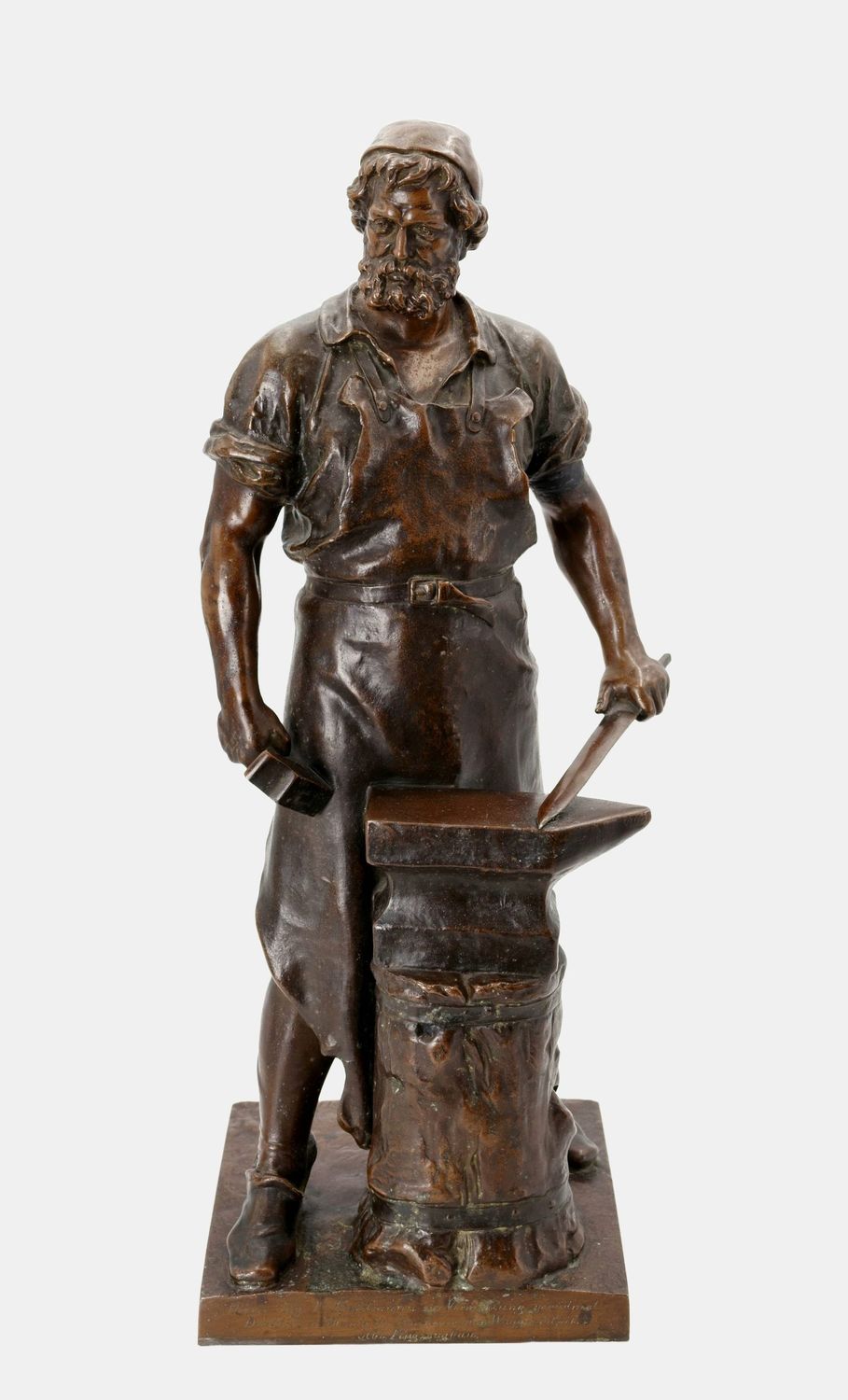Albermann, Wilhelm (1835-1913), Der Schmied von Solingen, nach 1895
Wilhelm Albermann(1835 Werden an der Ruhr - 1913 Köln), Der Schmied von Solingen , nach 1895. Bronzefarben patinierter Zinkguss auf gegossener Plinthe, 47 cm (Höhe) x 20 cm (Breite) x 16 cm (Tiefe), Gewicht 5,5 kg. Auf der Plinthe mit „Albermann.“ signiert und als Guss der „AKT.[TIEN] GES.[ELLSCHAFT] GLADENBECK BERLIN“ ausgewiesen. Schauseitige Widmung: „Herrn Ing. F. Kuhlmann zur Vermählung. Direktion und Beamte der Hannoverschen Waggonfabrik. Abt. Flugzeugbau“.
- Punktuelles Durchscheinen des Zinks, Patina etwas fleckig, der rechte Oberarm unter dem Ärmel schwarz retuschiert.
Exposé als
PDF
- Die Zweischneidigkeit des Schwertes -
Die Figur ist eine Reduktion von Wilhelm Albermanns 1895 geschaffener Brunnenfigur des Waffenschmieds von Solingen, der seit jeher mit dem historischen Schmied Peter Hahn identifiziert wurde. 1839 hatte Karl Simrock das Gedicht „Der Schmied von Solingen“ verfasst und damit die legendäre Figur geprägt. Die erste und die vorletzte Strophe lauten:
Zu Solingen sprach ein Schmied
Bei jedem Bajonette,
Das seinem Fleiß geriet:
»Ach, daß der Fritz es hätte!«
Der Krieg ging seinen Gang,
Man schlug noch viele Schlachten,
Die oft ihm angst und bang'
In seiner Seele machten.
Der Schmied hatte sein Handwerk ruhen lassen, um selbst für Friedrich den Großen zu kämpfen. Nicht zuletzt durch seine Kraft und seinen Kampfeswillen verliefen die Schlachten siegreich. Dem legendären Schmied verlieht Albermann mit seiner Brunnenskulptur eine bildliche Gestalt und schuf damit zugleich ein Wahrzeichen der Stadt Solingen, die einst für die Kunst des Schwerterschmiedens berühmt war und bis heute für die Herstellung qualitätvoller Messer einsteht. Beim Bombenangriff im November 1944 wurde mit der gesamten Solinger Altstadt auch der Brunnen zerstört. Einzig der Kopf blieb erhalten.
Mit sicherem Stand und umgebundener Lederschürze steht der breitschultrige Schmied hinter seinem Amboss und hat gerade mit seiner eigenen ‚Waffe‘ – dem Schmiedehammer – eine Schwertklinge fertiggestellt. Seinem gesamten Körper ist die Kraft abzulesen, mit der er den Hammer führt, aber auch die Anstrengung dieser Tätigkeit, wovon das weit geöffnete Hemd, die etwas ‚unordentlich‘ arrangierte Schürze und vor allem das zerfurchte Gesicht zeugen.
Der Schmied schaut aber nicht auf das vollendete Werk, sondern entschlossen und zugleich sinnierend in die Ferne, entsprechend der zitierten Zeile von Simrocks Gedicht, dass die Schlachten „oft ihm angst und bang‘ in seiner Seele machten“. Der Blick hat durchaus etwas Melancholisches, dass sich aus dem Wissen um die Notwendigkeit, Schwerter zu schmieden und zu den Waffen zu greifen und deren tödlichem Einsatz speist – Erfahrungen, die Albermann bei seinen eigenen Kriegseinsätze machen musste. Der wallende Vollbart verleiht dem in die Ferne schauenden Blick einen beinahe prophetischen Charakter.
Dem Handwerk der formvollendenden Schmiedekunst entsprechend, gibt der detaillierte Guss die jeweils dargestellten Materialien in vollendeter Ausformung wieder: Die Lederschürze vermittelt überzeugend den Eindruck des Leders und liegt – auch in der Rückenansicht – wie eine zweite ausgeformte Schicht über dem Körper, während das Hemd und die Hose die ihnen eigenen textilen Qualitäten veranschaulichen.
Aufgrund der meisterlichen Ausführung und dem tiefsinnigen Gehalt ist der in seinen gegossenen Reproduktionen erhalten gebliebene „Schmied von Solingen“ bis heute Albermanns berühmtestes Werk.
zum Künstler
Als Sohn eines Schreiners begann Wilhelm Albermann zunächst eine Lehre als Tischler, folgte dann aber seiner künstlerischen Berufung und absolvierte in Elberfeld eine Ausbildung zum Bildschnitzer. Als Zwanzigjähriger wurde er 1855 nach Berlin zum Militär einberufen und diente dort bis 1857. Nebenbei besuchte Albermann die Berliner Kunstakademie und begann nach seiner Dienstzeit ein reguläres Studium. Bereits als Student führte er Auftragsarbeiten für seine Lehrer August Fischer und Hugo Hagen aus. Erste eigenständige Aufträge folgten, die es ihm ermöglichten, 1865 in Köln eine prosperierende Bildhauerwerkstatt einzurichten. Seine künstlerische Tätigkeit wurde immer wieder von Einberufungen unterbrochen, so nahm er 1864 am Deutsch-Dänischen Krieg, 1866 am Krieg gegen Österreich und 1870/71 am Deutsch-Französischen Krieg teil. Im Anschluss an seinen letzten Kriegseinsatz gründete Albermann, der zu dieser Zeit bereits ein angesehener Künstler war, auf Wunsch der Stadtregierung eine Gewerbliche Zeichenschule, an der er die Modellierklasse leitetet und der er bis 1896 als Direktor vorstand. 1890 wurde er zudem für den „Verein zur Förderung der Bildhauerkunst in Rheinland und Westfalen" tätig.
Albermann gehörte in der zweiten Hälfte des 19.jahrhundets zu den produktivsten Kölner Bildhauern. Er schuf zahlreiche Denkmäler, Brunnen, Grabplastiken, architektonischen Schmuck und Statuen für den Wohnbereich. In seiner Werkstatt waren zu Hochzeiten bis zu dreißig Bildhauer und Steinmetze gleichzeitig tätig.

